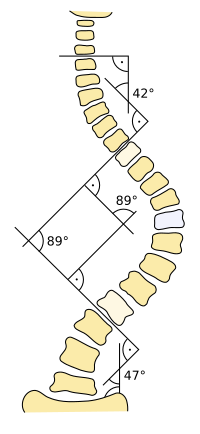
Photo from wikipedia
The Cobb angle measurement of the scoliotic spine is prone to inter- and intra-observer variations in the clinical setting. This paper proposes a deep learning architecture for detecting spine vertebrae… Click to show full abstract
The Cobb angle measurement of the scoliotic spine is prone to inter- and intra-observer variations in the clinical setting. This paper proposes a deep learning architecture for detecting spine vertebrae from X-ray images to evaluate the Cobb angle automatically. The public AASCE MICCAI 2019 anterior-posterior X-ray image dataset and local images were used to train and test the proposed convolutional neural network architecture. Sixty-eight landmark features of the spine were detected from the input image to obtain seventeen vertebrae on the spine. The vertebrae locations obtained were processed to automatically measure the Cobb angle. The proposed method can measure the Cobb angle with accuracies up to 93.6% and has excellent reliability compared to clinicians’ measurement (intraclass correlation coefficient > 0.95). The proposed deep learning architecture may be used as a tool to augment Cobb angle measurement in X-ray images of patients with adolescent idiopathic scoliosis in a real-world clinical setting.
Journal Title: Diagnostics
Year Published: 2022
Link to full text (if available)
Share on Social Media: Sign Up to like & get
recommendations!